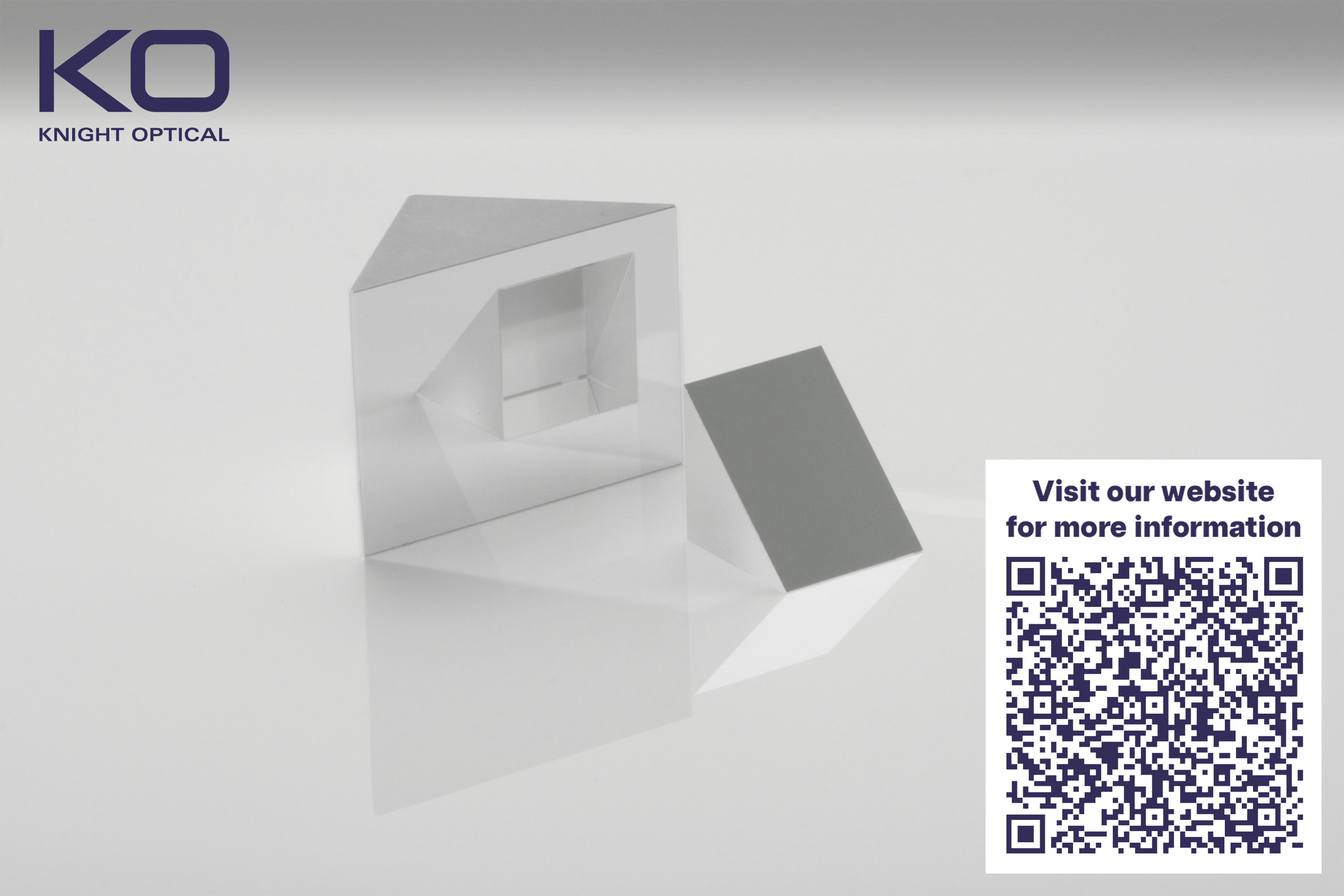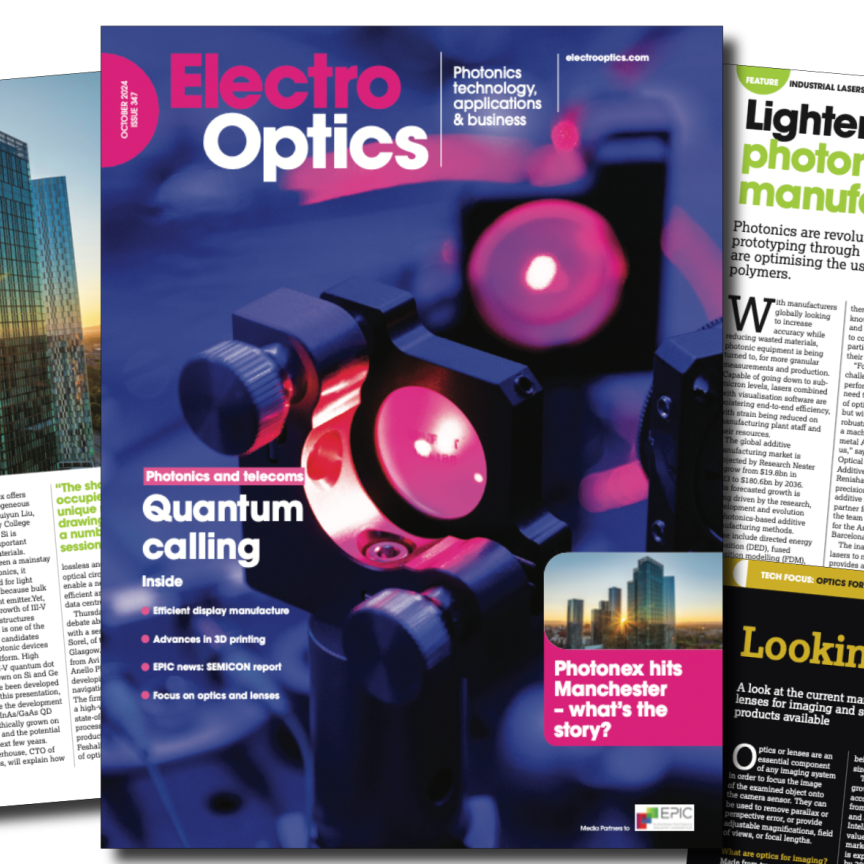Prisms are an established part of numerous photonic technologies, having been in existence for a very long time.
One of the first documented uses of these solid glass optics dates back to the 1660s, when Isaac Newton conducted a series of experiments with sunlight in which he identified the ROYGBIV colours (red, orange, yellow, green, blue, indigo, and violet) that make up the visible spectrum of clear white light.
An optical prism is a transparent object with flat, polished surfaces that refract light. Prisms are often used to split white light into its component colours or to recombine colours that have been separated. They are also used in instruments such as binoculars, periscopes, and telescopes to change the direction of light.
Prisms work using refraction, bending the light as it passes through a material with a different refractive index. When light enters a prism, it slows down and changes direction because the angle of incidence is not equal to the angle of refraction. This results in a separation of the light into its component colours (dispersion). The amount of dispersion depends on the angle and shape of the prism and the refractive index of the material it is made of. The different colours are bent at slightly different angles, causing them to exit the prism at slightly different locations. This is why white light entering a prism looks like a rainbow.
Types of prisms include dispersive prisms, which are used to break up light into its constituent spectral colours; reflective prisms, which are used to reflect light, in order to flip, invert, rotate, deviate or displace it; and beam splitting prisms, in which thin-film optical layers are deposited on the hypotenuse of one right-angled prism, and cemented to another to form a beam-splitter cube. Use cases for these types of prisms include imaging applications in the fields of spectroscopy, telecommunications, surveillance and astronomy, to name just a few.
Optical prism solutions on the market now
Vendors that offer optical prism solutions include A. Optical, which supplies a range of inverting, rotating, deviating, displacing or dispersing prisms.
Artifex Engineering has a variety of custom prisms, including all typical designs tailored to requirements. Prisms include: right-angle prism, dove prism, pentaprism, corner cube reflector, and wedge prism.
CeNing manufactures a range of precision prisms including right-angle prisms, wedge prisms, dove prisms, penta prisms, corner retroreflectors and rhomboid prisms. These are also offered in custom design.
Ecoptik provides optical prisms for various applications. The company can make many different geometrical shapes, including roof prisms, tetrahedral, wedge, octagon, penta, Powell and right-angle prisms. There is also an option for custom designs.
Available from Edmund Optics is a variety of designs, substrates, and coating options. Designs include right-angle, amici, penta, schmidt, wedge, anamorphic, equilateral, dove, or rhomboid prisms, in addition to corner cube retroreflectors or light pipe homogenising rods. Anti-reflection coatings include MgF2, UV-VIS, UV-AR, VIS 0°, VIS-NIR, or multiple laser line options.
FOCtek provides a range of high-precision prisms, including penta prism, beamsplitter penta prism, right-angle prism, and corner cube. The micro penta prism and right[1]angle prism are most widely used in optical communications, such as optical switches.
G&H produces prisms for a wide variety of applications, from high-energy laser cavities to broadband imaging systems. Prism types include: Abbe, Amici, Dove, Leman, penta, periscope, Porro, rhomboid, Schmidt, Wollaston, Zeiss, and others.
IRD Glass manufactures custom optical prisms for applications spanning laser optics to imaging devices. Available are basic right-angle prisms, rhomboid prisms, wedge prisms, penta prisms, dove prisms, roof prisms and many other variations and assemblies.
Kingsview Optical can manufacture optical prisms for a range of requirements from 0.8mm diameter micro prisms up to 100mm periscope prisms.
Perkins Precision Developments manufactures custom prisms and assemblies in numerous shapes and sizes and in a variety of materials including fused silica, fused quartz, N-BK7, YAG, ZnSe, SF11 and other high-index glasses. Prisms are available uncoated or coated with the company’s low-loss, high-energy IBS thin film coatings for applications in the UV, visible and near-infrared (NIR).
Precision Optical’s core product is the ultra-precise prism and the company manufactures numerous shapes from standard prism shapes to more intricate custom geometries. It can produce sizes from 3mm to 300mm, with or without custom thin film coatings, as individual components or as multi-component prism assemblies.
Available from Sydor Optics are custom optical wedges that can be used in a variety of applications. Flat optics with a wedge angle are typically used in laser applications for beam steering and beam displacement or for preventing stray-back reflections, and can also be used in optical components to change the direction of light.
Prisms available from Taiyo Optics include right-angle, penta, beamsplitter penta, corner cube reflector, porro, dove, rhomboid, brewster prism, and many more, including customised options.
This is not an exhaustive list. If you want your company included, please email: editor.electro@europascience.com.
Edmund Optics: Featured optical prism product
Edmund Optics is a world-class manufacturer of stock and custom optical prisms. The company produces more than 500,000 prisms per year from a wide variety of Schott, Ohara and CDGM substrates. Its factories utilise a full range of precision manufacturing equipment for grinding, polishing and fine-finishing, all supported by a comprehensive suite of metrology. These capabilities allow highly-skilled technicians to hit specifications such as λ/10 irregularity, 1 arc-minute angular tolerances and 10-5 surface quality.
World-class prism manufacturing facilities are complemented by a vast inventory of standard components that can be quickly modified for rapid prototyping. Where a fully custom prism is required, expert optical design and manufacturing engineers can help develop a solution.
All prisms are available with a wide range of anti-reflective coatings on the entrance and exit faces, as well as metallic coatings for reflective surfaces if needed.
Find out about Edmund Optics' range of optical prisms by visiting the company's website.
Knight Optical: Featured optical prism product
Knight Optical offers a versatile range of optical prisms, including customisable options tailored to your unique requirements. Prisms serve multifaceted roles, from dispersing white light into its spectral components to redirecting and manipulating light beams.
Below are the typical manufacturing capabilities we provide:
● Dimensions (mm): 5 to 300+
● Form Error (lambda): < 0.25
● Angular tolerance (arc minutes): < 3
● Scratch/dig: < 60/40
Our metrology lab rigorously tests each prism, ensuring precision and performance. Quality assurance measures include surface flatness and irregularity checks on our Zygo Verifire XPZ interferometer, angular tolerance assessments with our Trioptics PrismMaster, and transmission/reflection scans using our Agilent Cary 7000 Spectrophotometer. We also conduct infrared component testing with our Agilent Cary 660 FTIR spectrometer.
With Knight Optical you are guaranteed to experience unparalleled precision, quality, and innovation. Contact our UK and US teams today to explore bespoke optical solutions tailored to your specific needs.




